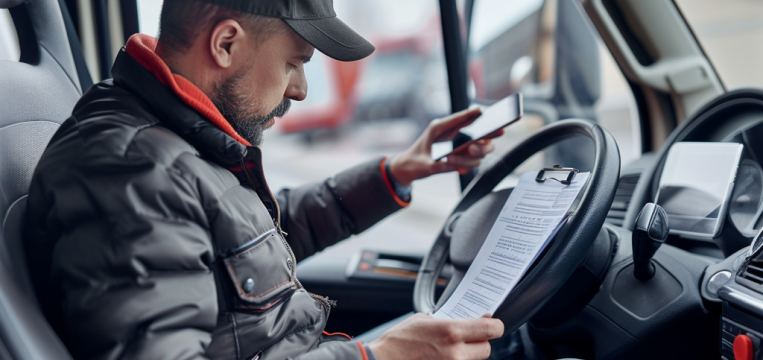Cargo theft is at an all-time high, and it seems unlikely that the numbers will drop soon. In 2023 alone, cargo theft caused a loss of $130 million in the U.S., and experts believe the actual figure to be even higher.
Fraudsters are getting increasingly creative when stealing cargo. In addition to physical theft, they now use the freight bidding process on load boards to snag loads – and run other scams.
In this article, we want to show you how thieves use new technology to target cargo, and how simple yet effective it is to use identity verification with a CDL Scanner to fight back.
New load board fraud techniques
Load boards are essential tools in managing cargo distribution across the U.S. They connect shippers and carriers and enable efficient logistics chains. Brokers use them to assign loads to carriers, who then deliver them according to the agreed-upon conditions.
However, the relative anonymity of these marketplace platforms makes them ripe for abuse. Users cannot just presume that their partner’s credentials are legitimate – scammers use identity theft and loopholes in the bidding process to obtain freight.
Two fraud schemes, in particular, are on the rise.
Load phishing
Scammers use legitimate trucking companies’ credentials and information to trick brokers into assigning freight to them. Contact details, such as email addresses, will seem legit to unassuming brokers, and the fraudulent carriers work with fake IDs or CDLs.
After a convincing email exchange and a successful negotiation, the cargo is loaded – but it will never reach its destination. Instead, the fraudsters will use it for their goals, often selling it on the black market.
Double brokering
In a double brokering scheme, the fake broker or carrier wins a bid on the load board. Rather than legitimately transporting it, or outright stealing it, they simply broker the load again.
Another unassuming carrier then takes it over – either for less money than the first one, or without getting paid at all. This harms both the original shipper and the carrier.
Still, despite their security issues, load boards are the most-used means of assigning cargo to carriers in the U.S. Fortunately, there are ways to counter these fraud schemes.
Identity verification with a CDL Scanner
Staying vigilant is essential, considering the resourcefulness of scammers. However, load boards offer little support in this regard.
The upside is that you can take matters into your own hands by adding a simple but effective step to your work process: using a CDL Scanner to verify any carrier’s identity and ensure that your load lands with the trucking company you expect it to.
The role of the Commercial Driver’s License (CDL)
CDLs are mandatory for any driver who conducts large vehicles to ensure that they can handle the requirements that come with it. Like any other driver’s license, CDLs require written and practical driving tests. The different classes of CDLs determine what kind of vehicle a driver is allowed to operate.
Every commercial driver is required to carry a CDL, and drivers are not allowed to have more than one. CDLs, like conventional driver’s licenses, contain written information about the driver that is also encoded in a PDF417 barcode.
They are unique, personalized documents that can be used for identification.
Using a mobile CDL Scanner
Where load boards don’t offer enough security options, you can bridge this gap using a mobile driver’s license scanner.
To ensure that your load will land in the hands of a legitimate driver, scan their CDL before letting them take over the load. The information encoded in the PDF417 barcode is harder to fake than the text on the document. Even if a driver’s license is otherwise a perfect counterfeit, scanning its barcode can expose it as a fake. Some scammers do forge the barcode as well. To make certain the CDL is legit, you can check the barcode data against a Driver License Data Verification Service.
Scanning CDLs with a mobile barcode scanner is a fast and cost-effective alternative to using dedicated scanning devices. You can easily integrate a CDL Scanner into your employee-facing mobile app for smartphones and tablets. Unlike an expensive single-purpose device, they can carry it around routinely and use it for a range of tasks.
Ultimately, scanning a CDL takes only milliseconds – but it could be all that stands between you and a load loss. In the long run, CDL scanning and verification could have a significant effect on load board fraud.
Introducing the Scanbot Driver’s License Barcode Scanner SDK
Integrate our Scanbot U.S. Driver’s License Scanner SDK into your app to automatically extract personal data from CDLs. The Scanbot SDK scans all common 1D and 2D barcodes and can parse the information encoded by the PDF417 barcode on the back of any AAMVA commercial driver’s license.
You can extract data like the driver’s names in 0.04 seconds without interrupting your employees’ workflow, and easily verify the document. The SDK has an accuracy of 98.7% and reads barcodes even in poor lighting conditions.
The Scanbot Driver’s License Barcode Scanner SDK works anywhere, anytime, and without internet access.
Since the SDK operates solely on the user’s mobile device, there is no connection to third-party servers. It thus complies with strict data protection regulations, safeguarding the sensitive personal data found on CDLs.







